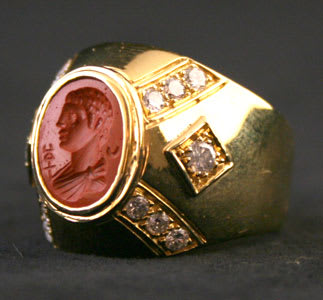Gold Ring Featuring a Roman Red Jasper Intaglio of Emperor Elagabalus, 218 CE - 222 CE
Gold, Diamonds
FJ.3350b
This genuine Ancient Roman red jasper intaglio depicting the bust of Elagabalus has been mounted in a stunning modern 18 Karat gold ring inset with diamonds. The draped bust of...
This genuine Ancient Roman red jasper intaglio depicting the bust of Elagabalus has been mounted in a stunning modern 18 Karat gold ring inset with diamonds.
The draped bust of Emperor Elagabalus faces to the left, with a military standard in the background on his left and a crescent moon on the right.
Elagabalus became emperor through the diligence and bravery of his grandmother, Julia Maesa. A powerful and immensely wealthy woman of the Severan family, she incited the Syrian legions stationed at Emesa to revolt against Macrinus in favor of her grandson. Although his Roman name was Bassianus, Elagabalus derives from his position as high priest of Elagabal, the Syrian god Ba’al. Elagabalus was one of the more scandalous rulers in Roman history. He was famed for hosting wild parties where overindulgence of all types was encouraged. The Eastern gods he brought to Rome were strange even to the permissive Roman society of the day. Perhaps his most offensive act was marrying a Vestal Virgin. To the Romans this act of Elagabalus not only desecrated their religion, but also their heritage. Julia Maesa attempted to regain control of the situation by having her other grandson, Severus Alexander, declared Caesar. When Elagabalus revoked this promotion, the Praetorian Guard, encouraged by Julia Maesa, rebelled against their emperor, hunted down, and executed Elagabalus.
The draped bust of Emperor Elagabalus faces to the left, with a military standard in the background on his left and a crescent moon on the right.
Elagabalus became emperor through the diligence and bravery of his grandmother, Julia Maesa. A powerful and immensely wealthy woman of the Severan family, she incited the Syrian legions stationed at Emesa to revolt against Macrinus in favor of her grandson. Although his Roman name was Bassianus, Elagabalus derives from his position as high priest of Elagabal, the Syrian god Ba’al. Elagabalus was one of the more scandalous rulers in Roman history. He was famed for hosting wild parties where overindulgence of all types was encouraged. The Eastern gods he brought to Rome were strange even to the permissive Roman society of the day. Perhaps his most offensive act was marrying a Vestal Virgin. To the Romans this act of Elagabalus not only desecrated their religion, but also their heritage. Julia Maesa attempted to regain control of the situation by having her other grandson, Severus Alexander, declared Caesar. When Elagabalus revoked this promotion, the Praetorian Guard, encouraged by Julia Maesa, rebelled against their emperor, hunted down, and executed Elagabalus.



